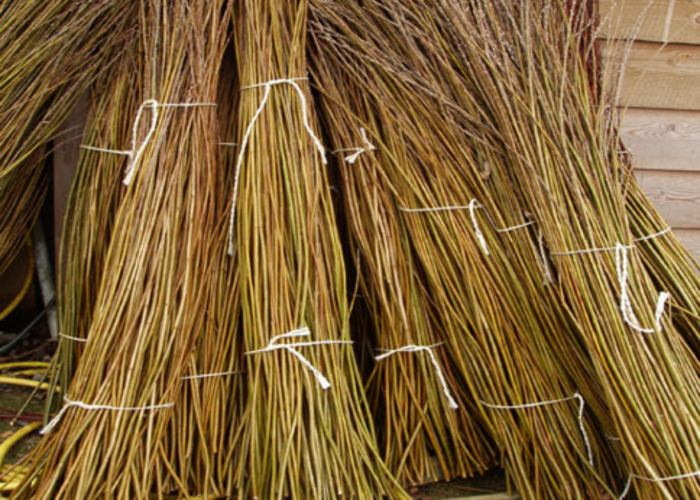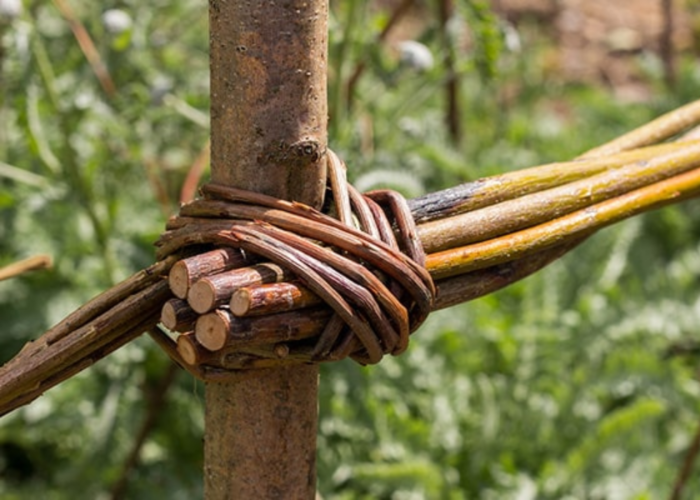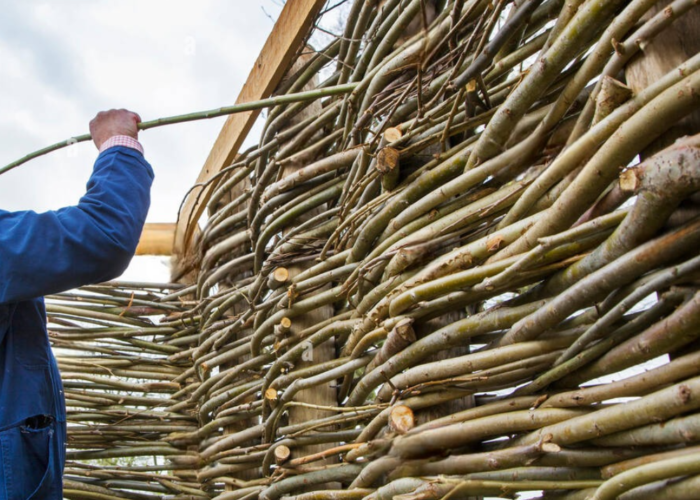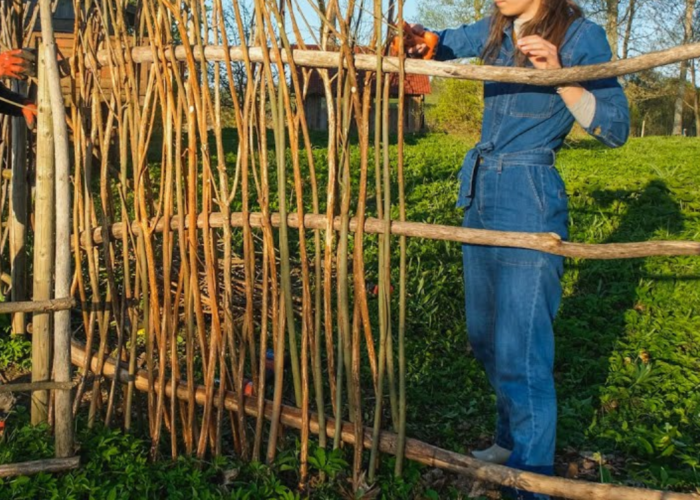A willow fence or hedge or hurdle is an aesthetically pleasing and sustainable way to create boundaries for your garden. Willow is a fast-growing, easy-to-cultivate tree that can be bent into various shapes. You can craft your own willow fence or hedge with a few simple tools and a touch of creativity.
In this article, we will guide you on how to make a willow fence or hedge, from basic steps to helpful tips. Have a read!
1. How to make a willow fence?
Willow fence is also called fedge/hedge or hurdle. Willow fences are known for their natural and rustic appearance, offering both functional and decorative features in garden and landscaping design. To make a willow fence, follow these steps:
Materials Needed:
- Willow branches (fresh or dried);
- Garden pruners or shears;
- Wooden stakes;
- Twine or flexible wire;
- Hammer.
Step 1: Gather willow branches
Collect fresh or dried willow branches. If using fresh branches, ensure they are pliable and have been soaked in water for a few hours to enhance flexibility.

Step 2: Prepare willow branches
Trim the willow branches to the desired length using garden pruners or shears. Remove any excess leaves or small twigs.
Step 3: Set up wooden stakes
Place wooden stakes into the ground at regular intervals to serve as support for the fence. These stakes will anchor the willow branches.

Step 4: Weave the willow branches
Starting at one end, weave the willow branches horizontally through the gaps between the wooden stakes. Begin with one branch, tucking it under the first stake, over the next, and so on. Repeat this process with additional branches, weaving them tightly to create a solid fence.

Step 5: Secure the ends
Once you’ve reached the desired height or length, secure the ends of the willow branches by wrapping them around the last wooden stake. Use twine or flexible wire to ensure a tight and secure fit.
Step 6: Trim excess branches
Trim any excess branches with garden pruners to achieve a neat and uniform appearance for your fence.

Creating a willow fence is a creative and sustainable way to enhance your garden’s aesthetics. The natural and rustic appeal of a willow fence adds character to outdoor spaces, making it a beautiful and functional addition to any landscape.
2. FAQs
2.1 Is willow good for fencing?
Yes, willow is an excellent choice for fencing, particularly for creating aesthetically pleasing and sustainable garden boundaries. Willow has several qualities that make it a favorable material for fencing:
- Flexibility: Willow branches are flexible and can be easily bent and woven into various shapes, making it ideal for crafting fences with intricate designs.
- Renewable Resource: Willow is a renewable resource, and its branches can be harvested without causing long-term damage to the tree. This makes it an eco-friendly choice for fencing.
- Natural Aesthetics: Willow fences have a rustic and natural appearance, blending well with outdoor environments. They add a touch of charm to gardens and landscapes.
- Functional and Decorative: Willow fences serve both functional and decorative purposes. They can act as effective barriers while enhancing the overall aesthetics of a garden.
- Biodegradable: Over time, a willow fence will naturally biodegrade, making it an environmentally friendly option compared to some synthetic materials.
2.2 How long does a willow fence last?
A willow fence can last from 10 to 20 years, depending on climate conditions, material quality, and maintenance practices. Willow fences are an environmentally friendly, durable, and aesthetically pleasing choice but require regular care to prevent decay, cracking, and fading.
Some ways to extend the lifespan of a willow fence include:
- Choosing high-quality, dry, and mold-resistant willow.
- Installing the fence on well-drained and elevated ground to avoid direct contact with moist soil.
- Applying a protective layer, such as a waterproof, mold-resistant, and UV-resistant coating, to the willow fence.
- Regularly inspecting and repairing minor damages on the fence, replacing broken or decayed willow branches.
- Cleaning the willow fence by sweeping off dust, washing with water and mild soap, or using a gentle pressure washer.”
Note: The information provided here is a translation and should be verified for accuracy and appropriateness based on specific contexts.
2.3 What willow is best for fence weaving?
Willows come in various types, but some of the most popular ones are white willow, red willow, and purple willow. Each type has its own advantages and disadvantages.
- White willow is known for its soft and flexible branches, making it ideal for weaving fences. It also has a beautiful and weather-resistant color. However, white willow is susceptible to issues such as insect infestation, mold, and warping when dried.
- Red willow has sturdier and more rigid branches compared to white willow, allowing for the creation of durable and robust fences. It boasts vibrant colors and is easy to care for. However, red willow can be challenging to bend, prone to breakage, and may fade when exposed to sunlight.
- Purple willow has slender and graceful branches, making it suitable for creating intricate and elegant fences. It features an eye-catching color and attracts attention. Nevertheless, purple willow is prone to breakage, drying out, and is more delicate against external factors.
Therefore, there is no right or wrong answer to this question, as it depends on your purpose, preferences, and budget. You can choose the type of willow that best suits your fencing needs.”
2.4 How do you preserve a willow fence?
To preserve a willow fence, start by selecting the appropriate type of willow for your climate and soil conditions. Trim and clean the willow, discarding any dry or moldy branches, and soak it in water for at least 24 hours to enhance flexibility. Install the fence according to your preferences, using sturdy posts and securing the willow with ties or nails.
Protect the fence by applying insecticides and fungicides annually, and shield it from extreme weather conditions. Regularly inspect the fence for damaged or discolored branches, replacing them as needed. With proper care, a well-maintained willow fence can remain an attractive and functional addition to your outdoor space for many years.
2.5 How do you attach a willow screening to a fence?
To attach a willow screen to a fence, you’ll need tools such as a hammer, nails, pliers, and ties. The first step is to measure the height and length of the fence to choose a suitable screen size. Next, align the screen with the fence and use nails to attach the corners of the screen to the wooden posts. Space the nails approximately 30 cm apart for secure attachment.
The final step involves using ties to wrap around the willow branches and the fence, enhancing durability and aesthetics. If necessary, trim any excess screen material with pliers for a tidy finish.
3. Conclusion
In conclusion, crafting a willow fence or hedge offers both practical and aesthetic benefits for garden enthusiasts. With its natural charm and sustainable qualities, a willow fence not only serves as a functional boundary but also enhances the overall beauty of outdoor spaces.
By following the simple steps outlined in this guide, anyone can create a personalized and eco-friendly addition to their garden landscape.
If you have any further questions, don’t hesitate to send thanhcongcraft an email us at info@thanhcongcraft.com or message us at WhatsApp: +84967485411. Hope to serve you soon! Best regard!












